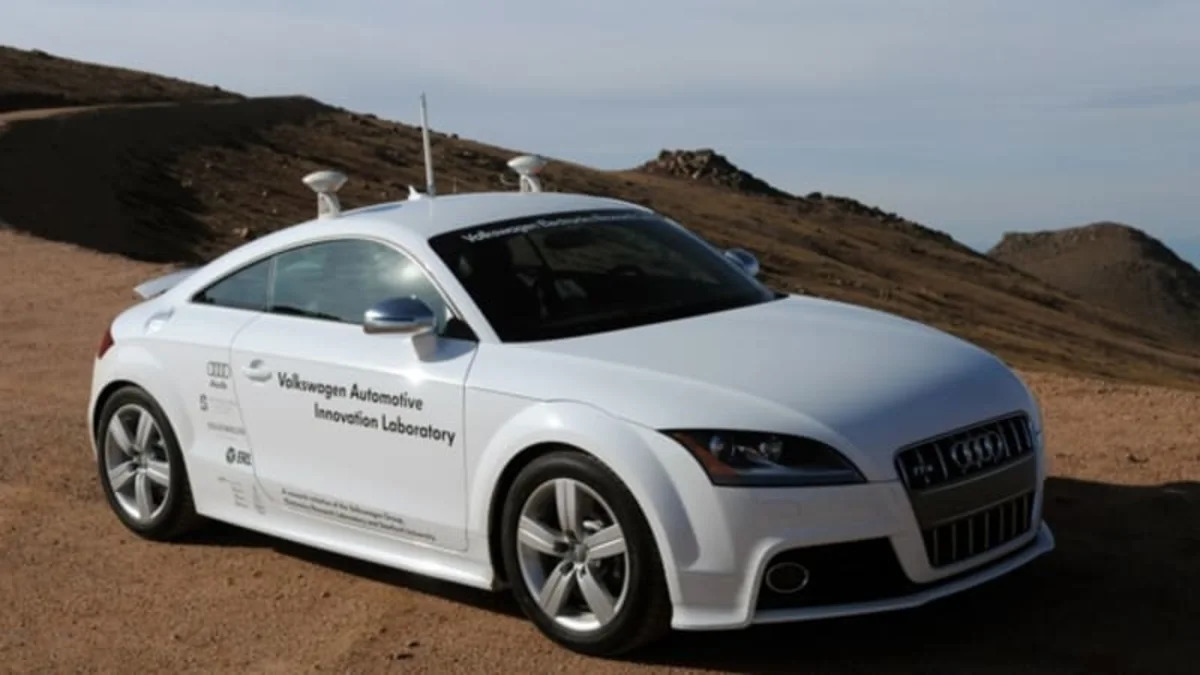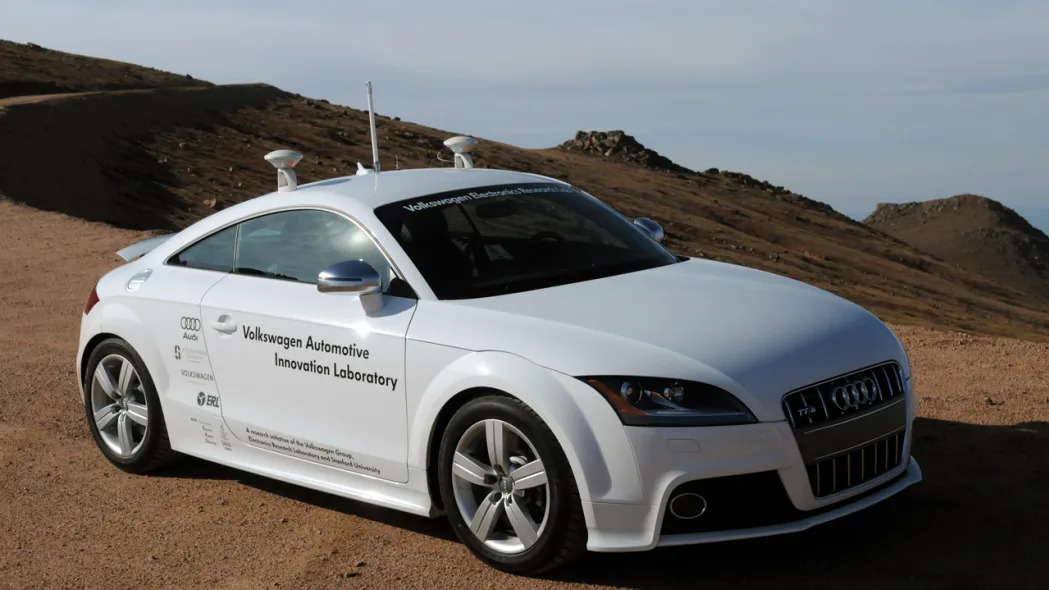We first heard about the latest autonomous driving project from Stanford University and the Volkswagen Group a couple of weeks ago. Audi has released some more information on the car, a TT-S coupe that, like its predecessors, Stanley and Junior, has a name: Shelley. Shelley's being developed to climb Colorado's Pikes Peak without any driver intervention during the annual hill climb next July. (Stanley and Junior were created for the DARPA Grand Challenge and Urban Challenge.)
Audi and Stanford's Dynamics Design Lab have managed to dramatically reduce the size of the equipment necessary for the car and its control system to detect the surroundings and respond accordingly. That it can all fit into the compact TT's body while sprouting just a trio of sensors from roof is quite an accomplishment. One of the goals of this year's effort is to have the car perform the way it would with a professional rally driver at the wheel, including drifting on the gravel. As of its name, "Shelley" refers to the nickname of Michelle Mouton, the most successful female rally driver of all time and the first woman to win at Pikes Peak, a feat she accomplished behind the wheel of the legendary Audi Sport Quattro in 1985.
Audi and Stanford's Dynamics Design Lab have managed to dramatically reduce the size of the equipment necessary for the car and its control system to detect the surroundings and respond accordingly. That it can all fit into the compact TT's body while sprouting just a trio of sensors from roof is quite an accomplishment. One of the goals of this year's effort is to have the car perform the way it would with a professional rally driver at the wheel, including drifting on the gravel. As of its name, "Shelley" refers to the nickname of Michelle Mouton, the most successful female rally driver of all time and the first woman to win at Pikes Peak, a feat she accomplished behind the wheel of the legendary Audi Sport Quattro in 1985.
[Source: Audi]
PRESS RELEASE
All about the Audi Pikes Peak TTS
The Audi Pikes Peak TTS is nicknamed "Shelley" by the Stanford DDL after Michele Mouton, arguably the most successful female rally driver to date who played a significant part in Audi's racing history.
Goal
To collaborate with Stanford to build an autonomous vehicle capable of completing the Pikes Peak International Hill Climb in a reasonable time using rally driving techniques.
Team:
Volkswagen Electronics Research Lab
Convert a vehicle to drive by wire, develop a safety architecture to ensure a reliable autonomous drive with no safety driver, and implement Stanford's control algorithms on a system jointly developed with Sun Microsystems.
Stanford Dynamics Design Lab
Develop robust control algorithms that enable the vehicle to drive at the limits of handling on a variety of surfaces, and lets it complete the Pikes Peak course.
Sun Microsystems
Specify a hardware platform that can run Stanford's real time algorithms and develop a framework that enables Real Time Java to the vehicle CAN system.
Convert a vehicle to drive by wire, develop a safety architecture to ensure a reliable autonomous drive with no safety driver, and implement Stanford's control algorithms on a system jointly developed with Sun Microsystems.
Stanford Dynamics Design Lab
Develop robust control algorithms that enable the vehicle to drive at the limits of handling on a variety of surfaces, and lets it complete the Pikes Peak course.
Sun Microsystems
Specify a hardware platform that can run Stanford's real time algorithms and develop a framework that enables Real Time Java to the vehicle CAN system.
Vehicle:
Make and model: 2009 Audi TTS
Engine: 2.0L Turbocharged I4 DOHC
Transmission: 6-Speed S tronic automatic transmission
Fuel Consumption: City: 21 mpg
Highway: 29 mpg
Combined: 24
Power: 265 hp & 6000 rpm1Combined: 24
Torque: 258 lb-ft. @ 2500 – 5000 rpm
Top speed: 155 (249km/h),
Acceleration: 0-60mph: 4.9sec Weight incl. sensor: ~ 1470kg.
Drive-By-Wire:
Steering: Modified "APA-BS" (Axially Parallel Actuation-Braun-Schweig), a new production electric power steering system with direct by-wire control through custom ERL Electronics.
Throttle: Electronics from VW ERL reproduce signals to emulate a driver pressing on the throttle.
Brakes: Active brake booster from Continental with by-wire control through ERL Electronics.
Gear: Modification of signals exchanged between transmission and gear shifter using custom ERL electronics on production hardware.
Parking brake: Use of stock electric parking brake from VW Passat through a custom ERL electronic interface utilized on Junior.
Safety:
In addition to multiple redundant systems for vehicle control, and emergency shutdown the Pikes Peak TTS has a Solaris based system running a Java RTS system monitor that can perform a vehicle shutdown if it determines conditions have become unsafe.
As a backup solution, the vehicle includes a telemetry system that can transmit all vehicle parameters to a receiving station up to 20 miles away which can also shut down the vehicle remotely, or order the safety systems to engage and bring the car to a controlled stop.
Sensors:
The Pikes Peak TTS utilizes an Applanix POS LV420 GPS and Inertial Measurement Unit to measure its position.
Vehicle Control:
Hardware:
Two independent systems are being used in the Pikes Peak TTS, the initial controller development is being done on an XPC target using Matlab and Simulink which are the standard research tools from Stanford's DDL. The final vehicle controls are being run on ruggedized custom built solutions running a Core2Duo CPU and Solaris operating system that is being developed in collaboration with Sun Microsystems.
Software:
The Stanford University Dynamics Design Lab is developing cutting edge control algorithms that look to optimize the ability to control the vehicle under the most demanding circumstances. As these algorithms are finalized they will be merged into a new framework being developed at the ERL based that shares many components with other ERL Autonomous driving projects.






Sign in to post
Please sign in to leave a comment.
Continue